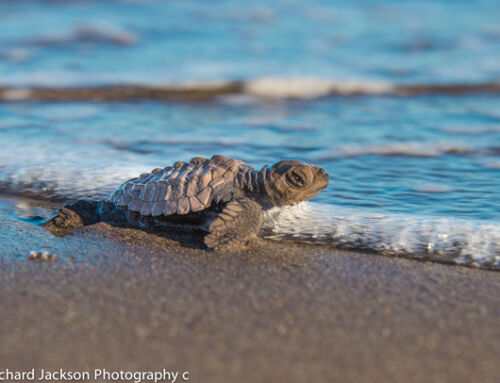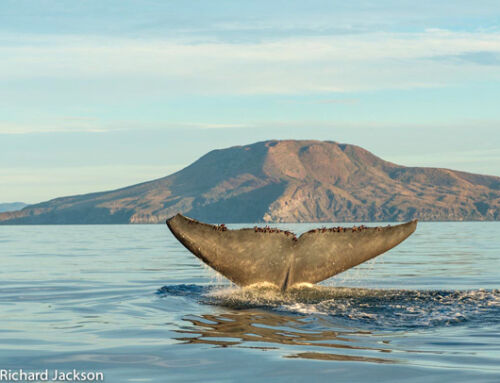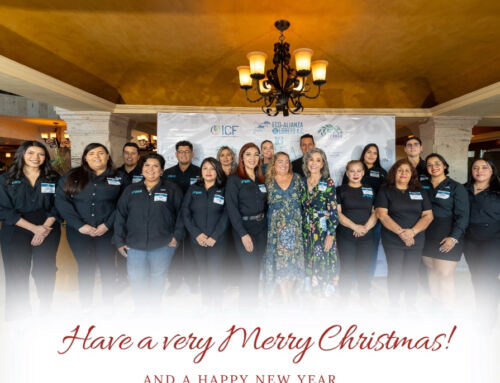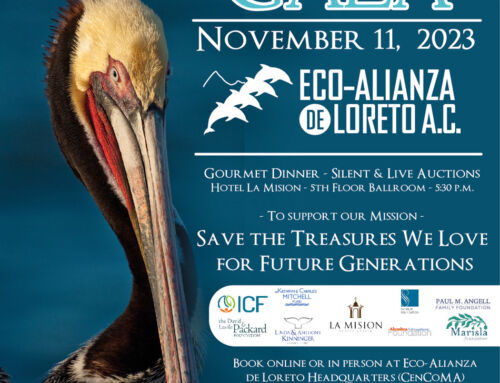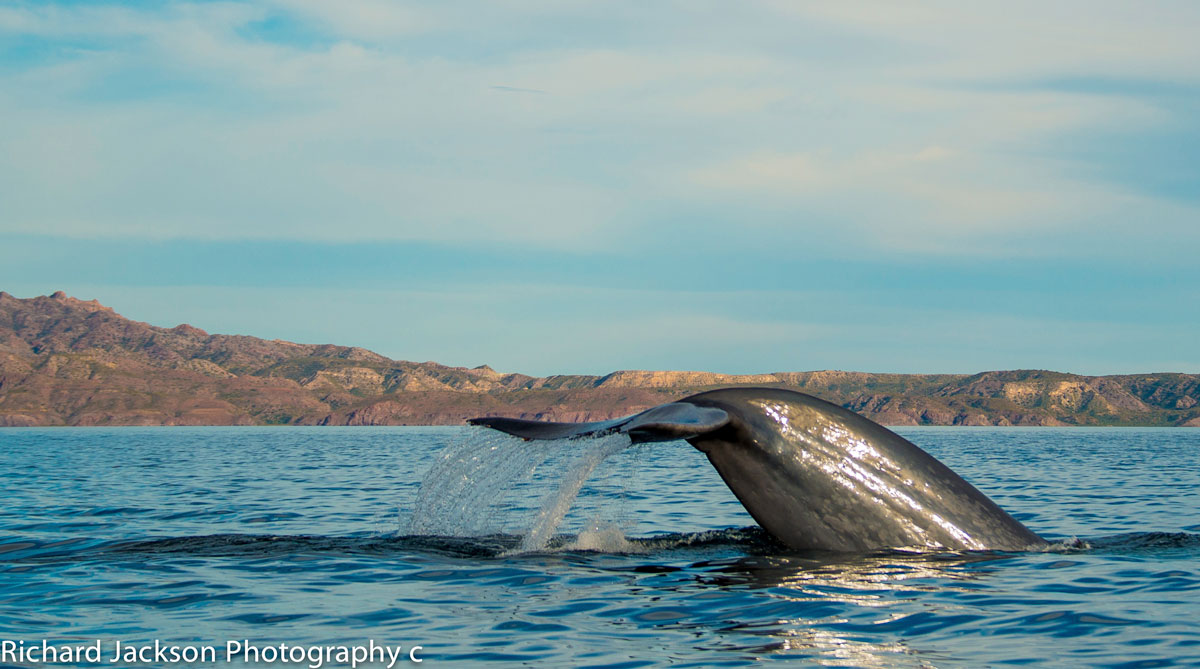
Photo courtesy of Richard Jackson
In celebration of this year’s Loreto Blue Whale Festival, we spoke with Mariana Salgado, Park Ranger and Biologist for the Parque Nacional Bahía de Loreto (PNBL) and also to Bryan Olachea, a Blue Whale researcher who will present “Gigantes del Mar,” a free, bilingual Visiting Scientist talk at the Chili Wili large open-air palapa on the Loreto Malecon, just north of the lighthouse at 5:00 p.m. on March 20.
 Both Bryan and Mariana confirmed an astounding result from one day of whale research in mid-February, when researchers identified 13 individual Blue Whales, mostly in the southern end of the Park. One of the whales was a female who was first identified here in 1985 and in 13 different years since then, three times with offspring swimming alongside. Last year the total number of whales for the entire season was 13, and the previous year it was 11. The bulk of the Blue Whale season in Loreto is February and March. Bryan reported that as of March 13, at least 20 different Blue Whales have been identified this season, an increase of over 50 percent over last year’s totals. And typically, more whales continue to arrive into mid- or late March. He also said the research team has yet to examine many of the photos they have taken, so the number could be higher.
Both Bryan and Mariana confirmed an astounding result from one day of whale research in mid-February, when researchers identified 13 individual Blue Whales, mostly in the southern end of the Park. One of the whales was a female who was first identified here in 1985 and in 13 different years since then, three times with offspring swimming alongside. Last year the total number of whales for the entire season was 13, and the previous year it was 11. The bulk of the Blue Whale season in Loreto is February and March. Bryan reported that as of March 13, at least 20 different Blue Whales have been identified this season, an increase of over 50 percent over last year’s totals. And typically, more whales continue to arrive into mid- or late March. He also said the research team has yet to examine many of the photos they have taken, so the number could be higher.
Mariana pointed out that cold water currents this year seem to have significantly increased the quantity of krill in the Park, which is a main food source for Blue Whales. She said on the day they identified 13 whales they also observed the whales feasting on krill on the surface of the water.
Individual Blue Whales can be identified visually by markings on their tails, by their dorsal fins, or by distinct mottling and spots on the surface of their skin. Four researchers from the Centro Interdisciplinario de Ciencias Marinas (CICIMAR) in La Paz are here for most of the season to identify individual whales and also to collect samples of whale scat and mucus for DNA and other biological analyses. The students study under the internationally renowned whale researcher Dr. Diane Gendron.
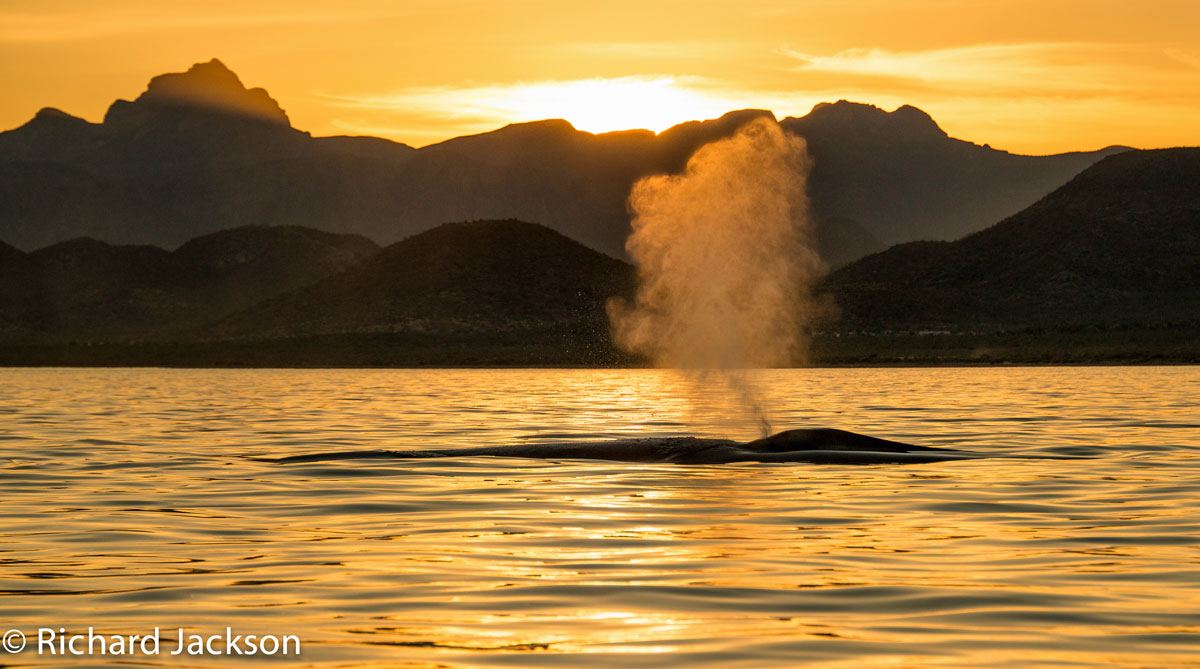
Photo courtesy of Richard Jackson
Since 2014, Mariana said, Dr. Gendron has been training local panga captains and other whale watchers in the techniques of passive observation of Blue Whales, “absolutely resulting in a more intimate experience” for observers. Upon seeing a whale nearby, boat motors are turned off. Instead of chasing whales, as used to be common practice, whales are allowed to peaceably surface and feed in silence, often resulting in six or seven sightings instead of one or two, and in whales often swimming in a large circle around the whale watching boats, and coming much closer. “It gives visitors the opportunity not only to see them and take photos, but also to hear them breathe,” Mariana said, “which is an unforgettable experience.” Blue Whales can weigh up to 190 tons and measure nearly 30 meters in length.
Mariana reminds would-be whale watchers that Park regulations are designed to protect the whales and other wildlife, and to improve the whale watching experience for everyone. Boat captains are required to be trained and to have a whale watching permit, generally signified by a red flag on the boat. About 60 local captains have the permit, she said. Dinghies, kayaks, and paddleboards are not permitted for whale watching, she pointed out, and use of drones over whales, sea lions, or birds require a special research permit. To respect the privacy of park visitors, she recommends that drones also not be used in the vicinity of inhabited beaches.
A useful educational video explaining whale watching regulations and suggestions was posted February 10 on the Park’s Facebook page at Parque Nacional Bahía de Loreto. Enjoy!

Eco-Alianza staff photo
Out of consideration for public health, the One Ocean Film Festival scheduled for March 20 and 22 has been postponed until the evenings of October 16 and 17. We expect to screen the same films previously announced. Patrons who have purchased tickets may use them in October or return them to Eco-Alianza for a full refund. If you prefer a refund, please send an email before March 23 to: info@ecoalianzaloreto.net . We regret the inconvenience and appreciate your understanding in these challenging times.
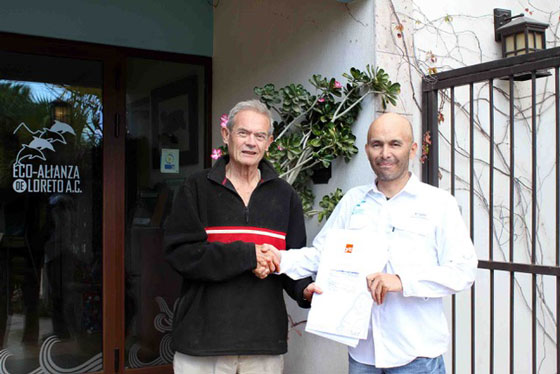
Eco-Alianza staff photo
Jim Gries turns over his Loreto home’s title to Eco-Alianza President/CEO Hugo Quintero
Long-time Eco-Alianza supporter Jim Gries says he has a natural ally in Eco-Alianza because he is strongly in favor of preserving the traditional plants and animals in the desert near Loreto, and also because he favors modifications in law and practice of a sustainable fishery in Loreto. Like many Americans who come here, Jim was drawn to Loreto by the extraordinary fishing and the beauty of the desert. That was 40 years ago!
When Jim first visited Loreto in 1980, he says, there was a roadside sign that indicated a population of 3,000 in the quaint fishing village. Since the mid-’70s he had taken many fishing trips to the East Cape, and thought he’d try his luck farther north, having heard great tales about Loreto fishing. He discovered that the town’s fishing reputation was if anything understated.
“With little choice in hotels I usually stayed at either the Oasis or the old Mission,” Jim says, “and there were few appealing unaffiliated restaurants. It was hard to find a paved road and one rarely saw a Mexican-owned motor vehicle.” He was delighted to find the populace “friendly and helpful and the fishing guides cautioned against wasteful practices. Americans and Canadians sometimes joked among themselves about identifying the government agency responsible for picking which Mexican family was responsible for caring for us.”
By the turn of the century, Jim was convinced. “I retired, bought a lot in Loreto, drafted rough plans for a house, and turned the job over to Jesus Cortes.” Jim had been born in Connecticut, far from any deserts, but discovered the beauty of them in Tucson in 1960. “My father had accepted an appointment as a department head at the University of Arizona,” he says. “I drove one of the family cars out and quickly fell in love with the Arizona desert.” A week later he returned East for four years at Harvard, but returned in the summers for desert hikes. Then he returned for three years to attend the University of Arizona’s Law College.
Jim’s law career began with the Navy’s Judge Advocate General (JAG) corps, serving in Vietnam and Japan, and ultimately his discharge from the military in San Francisco. He inquired about a clerkship with the Chief Justice of California, accepting a traditional one-year position. The clerks served as a central staff for the entire court as well as the Chief Justice’s personal staff, Jim says, and before his year was completed, he was changed to a permanent position. Jim never looked back.
Now, in retirement, Jim splits his time between San Francisco and Loreto. He has served as a volunteer with the San Francisco Ballet “for decades now,” and says he’s ready to leave a legacy here in Loreto to support Eco-Alianza’s burgeoning “Sister Reserve” relationship with the University of California’s Natural Reserve System (UCNRS). Jim’s home here will serve almost immediately as a landing place for research scientists who will soon begin arriving in Loreto connected to graduate-level research projects.
“Obviously, Jim’s commitment and generosity are extraordinary,” says Linda Kinninger, Treasurer of Eco-Alianza’s Board of Directors. “This couldn’t come at a better time, as researchers already are arriving this month,” she says. “The housing will immediately add a welcome element to Eco-Alianza’s rapidly expanding relationship with UCNRS, and we couldn’t be happier,” she adds. “Loreto’s natural wonders will be well served by Jim’s kind and generous donation.”
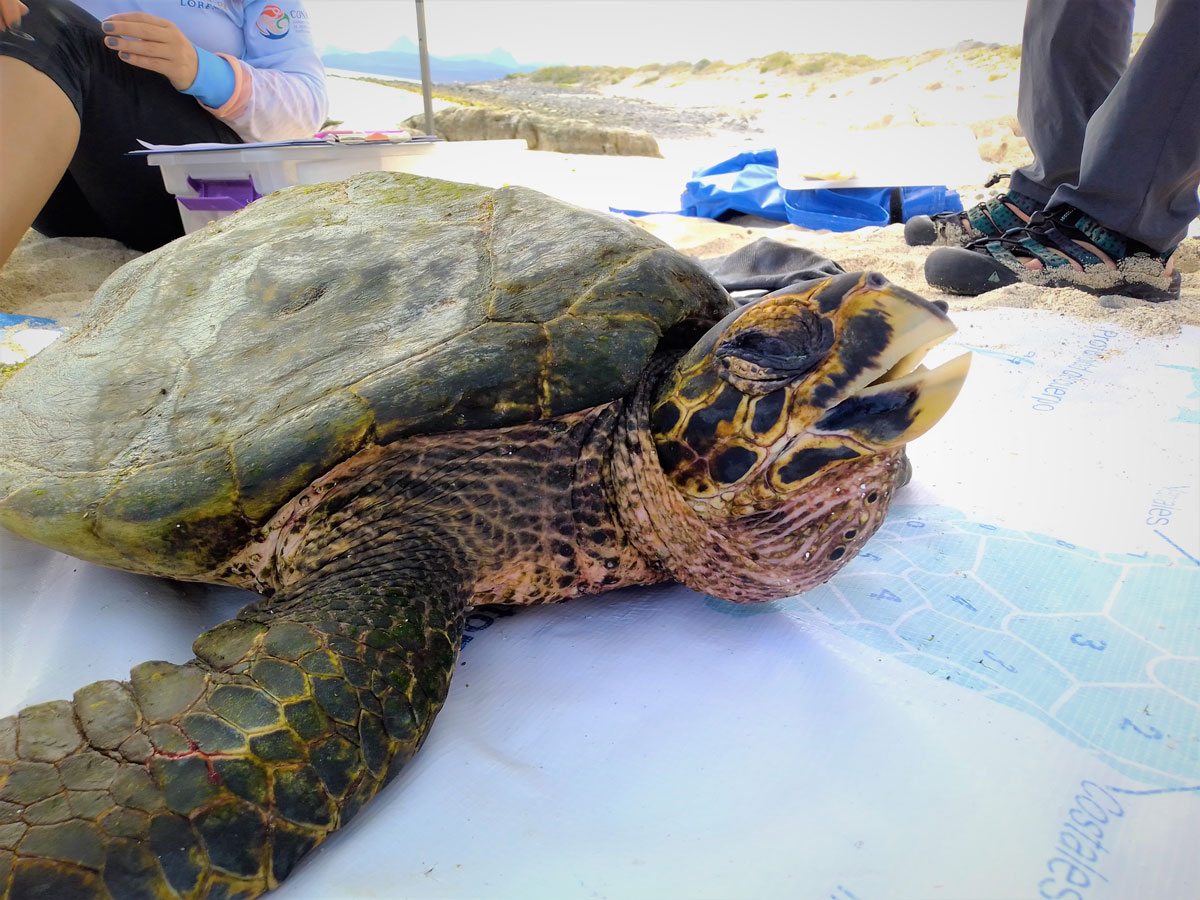
Eco-Alianza staff photo
In early February, several Eco-Alianza staff members participated in a training workshop and field trip regarding sea turtle conservation. A trainer from Grupo Tortuguero de Las Californias, Jesus Salvador “Chuy” Lucero, spent a full day teaching techniques on capturing, identifying, measuring, tagging, and releasing sea turtles in the Bay of Loreto National Park (PNBL).
With special permission from Park authorities, the team traveled to Isla Coronados and set underwater nets to capture sea turtles, checking the nets every hour to make sure any captured turtles were not held underwater for too long (since sea turtles need to come to the surface to breathe air). Although they saw several turtles on their journey, their excursion resulted in only one capture.
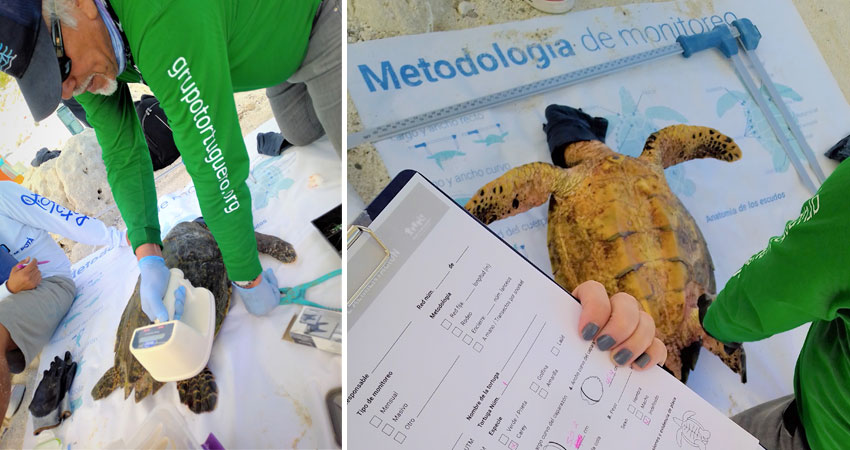
Eco-Alianza staff photo
But, coincidentally, it was a very special one. Nearly all turtles that nest in PNBL are Green sea turtles (chelonia mydas) or Tortuga Prieta in Spanish. The turtle captured, however, was a Hawksbill (eretmochelys imbricata), or Tortuga Carey in Spanish, apparently the first one ever captured near Coronados Island. Hawksbill populations were decimated in the mid-20th century when it became fashionable to use eyeglass frames and combs crafted from their beautiful carapace. After freeing the turtle from the net, Eco-Alianza staffers carefully carried it ashore and learned the best techniques to weigh it, measure its shell, note its condition, and record all the data on a standardized data sheet.
Before releasing the sea turtle back into the water, they attached a metal numbered flipper tag, as well as injecting a machine-scannable chip under the skin (similar to the identification microchip that veterinarians inject under the skin of dogs or cats to identify them if they are lost).
According to Eco-Alianza President and CEO Hugo Quintero, the training session was an important capacity-building step in the development of Eco-Alianza’s sea turtle conservation program. Over several years, Eco-Alianza has worked with Park authorities and hired local beach monitors to record results of sea turtle nesting on area beaches. In addition to supporting monitoring programs, however, Hugo explained that Eco-Alianza seeks to develop a sea turtle research and conservation program to gain knowledge about turtle populations here and to work to improve conditions for nesting and foraging turtles by developing an accurate database in coordination with the Park and with other researchers and sea turtle conservation groups.
Grupo Tortuguero, headquartered in LaPaz, is a network of individuals and groups in eight Mexican states along the Pacific coast and in the Gulf of California. It includes 20 groups or communities in Baja California Sur. The group’s main program areas include sea turtle conservation, beach monitoring, research, and environmental education. For more information, visit grupotortuguero.org .
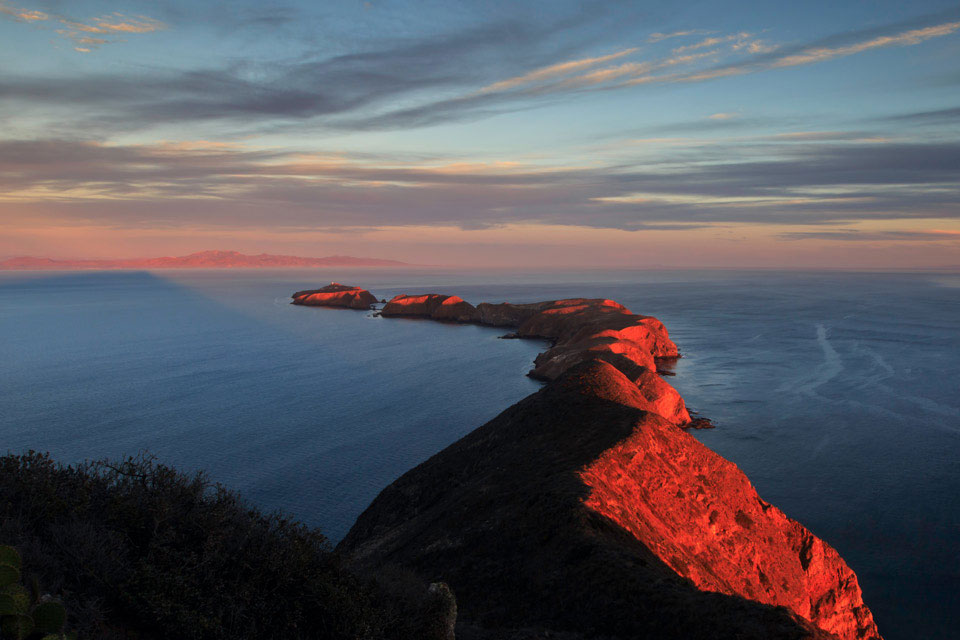
Photo courtesy of Tim Hauf, timhaufphotography.com
On March 5, PNBL’s “Sister Park” celebrated its 40th anniversary with presentations, special activities, and celebratory events. Like PNBL, the Channel Islands National Park (CINP) includes five islands and the waters around them, and protects an astounding array of plants and animals. Considered by some to be “the North American Galapagos,” CINP features more than 140 species found nowhere else on earth. More than 100,000 seals and sea lions call the Park home, and Blue Whales are summer residents.
Park Superintendent Ethan McKinley led an array of activities on the Park’s special day, including lectures, storytelling, films, dock tours of Park vessels, and a native plant sale. Park biologists with the kelp forest monitoring team demonstrated long-term monitoring techniques they use to better understand the health of the marine environment.
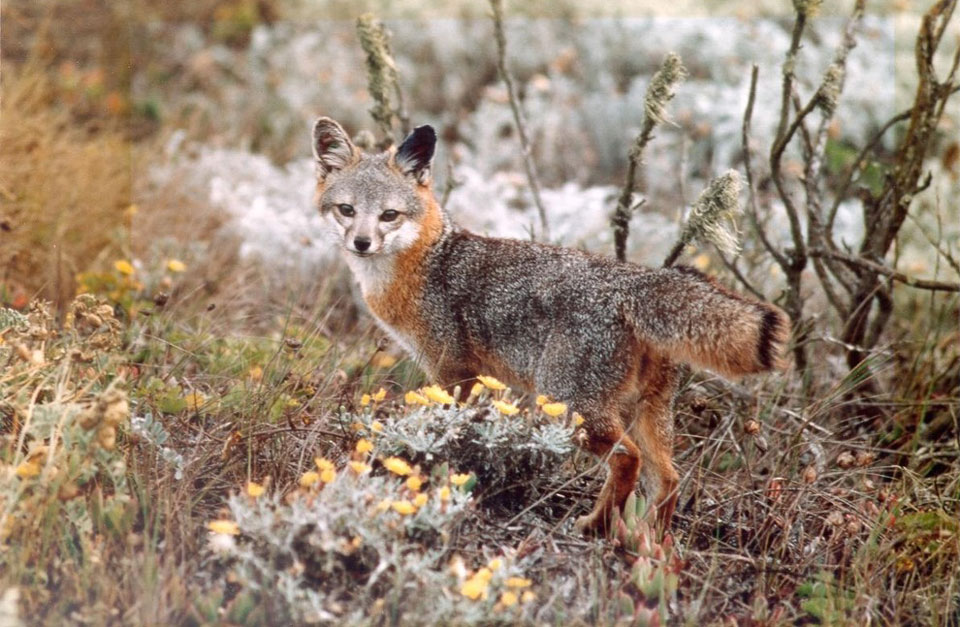
Photo courtesy of Tim Coonan
The Island Fox, native to CINP, is found nowhere else in the world and is about the size of a house cat.
In late 2016, under the National Park Service’s International Sister Parks program, CINP officially became the Sister Park of PNBL. The agreement, in which Eco-Alianza was instrumental, was formalized with a signing in Hawaii at the quadrennial meeting of the International Union for the Conservation of Nature (IUCN).
CINP marine scientists have extensive experience initiating and tracking success in “no-take” fishery replenishment zones, such as the ones in PNBL’s recently approved revised Park Management Plan, which expanded the number of such zones within PNBL from 2 to 15. Sister Park status makes PNBL’s success part of the mission of CINP, and managers already have offered assistance to Loreto’s marine park.
With 40 years of conservation success under its belt, including development of a sustainable fishery, CINP’s anniversary offers a lot to celebrate for both the human and biological residents of Loreto. For more information, visit nps.gov/chis .
![]()
“Nature Notes” is a monthly short feature detailing some of the wondrous, seasonal activities taking place around us.

Photos courtesy of Tom Haglund/BCS Birds
Photos, clockwise from top left:
Close inspection of formidable talons.
A one-footed carry of a Halibut is no biggie for an Osprey.
This fray between a thrashing Tilapia and an Osprey ended in the Osprey’s favor.
Our friend in its dilemma as a sinking sun slowly closed the scene for the night.
By Tom Haglund
We all know what we mean to convey when we say, “… bit off more than could be chewed.” We took on a larger project than was doable. Many predators have built-in safeguards against doing this. They usually are able to undo the predicament of having taken on too much to handle. Too much to swallow, too tough to kill, too wiggly to hang on to, too big to climb a tree with, or just suddenly seeming more dangerous than supposed. Vomiting, abandoning, even fleeing are bailout schemes that can buy a failed predator another chance.
Ospreys sometimes don’t have the choice of hitting the undo button to right a wrong grab. Their talons are perfect for grasping slippery, wriggly prey without any option to let it go. Those long deeply-curved hooks are one-way tools. The texture of the toe pads and the depth of the curves combine to make the hold stronger when it is tested, not weaker. As the Osprey attempts to release its grip the thrashing of the fish drives those fearsome points ever deeper into its own flesh. The osprey just simply isn’t allowed to change its mind on prey selection. Too big to fly with, once latched onto, can even be a death sentence for the bird.
We came across an Osprey that had fastened onto a fish too heavy to fly with and watched the frustrated raptor stand belly deep in the bay at Guerrero Negro feeling the tide rise and unable to get aloft with what must have been a biggun. We never saw the fish. The Osprey was still standing there when the last light faded and we had to go. In the morning there was no sign of them, and, of course, having the luxury of being able to make up whatever ending we wished, we allowed it to escape its predicament and fly away.
Spanish names:
Osprey – Gavilán Pescador
Halibut – Lenguado
Visiting Scientist Bryan Olachea
Free Bilingual Presentation on Blue Whale Research
New location– Chili Wili large open-air palapa Loreto Malecon just north of the lighthouse
5:00 p.m.[/content_box][content_box title=”April 5″ icon=”” backgroundcolor=”” iconcolor=”” circlecolor=”” circlebordercolor=”” circlebordersize=”” outercirclebordercolor=”” outercirclebordersize=”” iconrotate=”” iconspin=”no” image=”https://ecoalianzaloreto.org/wp-content/uploads/2020/03/Screen-Shot-2020-03-16-at-8.49.14-PM.png” image_width=”350″ image_height=”350″ link=”” linktext=”” link_target=”_self” animation_type=”” animation_direction=”” animation_speed=””]Set Your Clocks Ahead
Loreto Daylight Savings Time Begins
2 a.m.[/content_box][content_box title=”Friday, October 16 & Saturday, October 17″ icon=”” backgroundcolor=”” iconcolor=”” circlecolor=”” circlebordercolor=”” circlebordersize=”” outercirclebordercolor=”” outercirclebordersize=”” iconrotate=”” iconspin=”no” image=”https://ecoalianzaloreto.org/wp-content/uploads/2020/03/Screen-Shot-2020-03-16-at-8.48.54-PM.png” image_width=”350″ image_height=”” link=”” linktext=”” link_target=”_self” animation_type=”” animation_direction=”” animation_speed=””]Save the Dates
Rescheduled One Ocean Film Festival
Eco-Alianza Courtyard[/content_box][content_box title=”November 14″ icon=”” backgroundcolor=”” iconcolor=”” circlecolor=”” circlebordercolor=”” circlebordersize=”” outercirclebordercolor=”” outercirclebordersize=”” iconrotate=”” iconspin=”no” image=”https://ecoalianzaloreto.org/wp-content/uploads/2020/03/Screen-Shot-2020-03-16-at-8.49.22-PM.png” image_width=”350″ image_height=”” link=”” linktext=”” link_target=”_self” animation_type=”” animation_direction=”” animation_speed=””]






